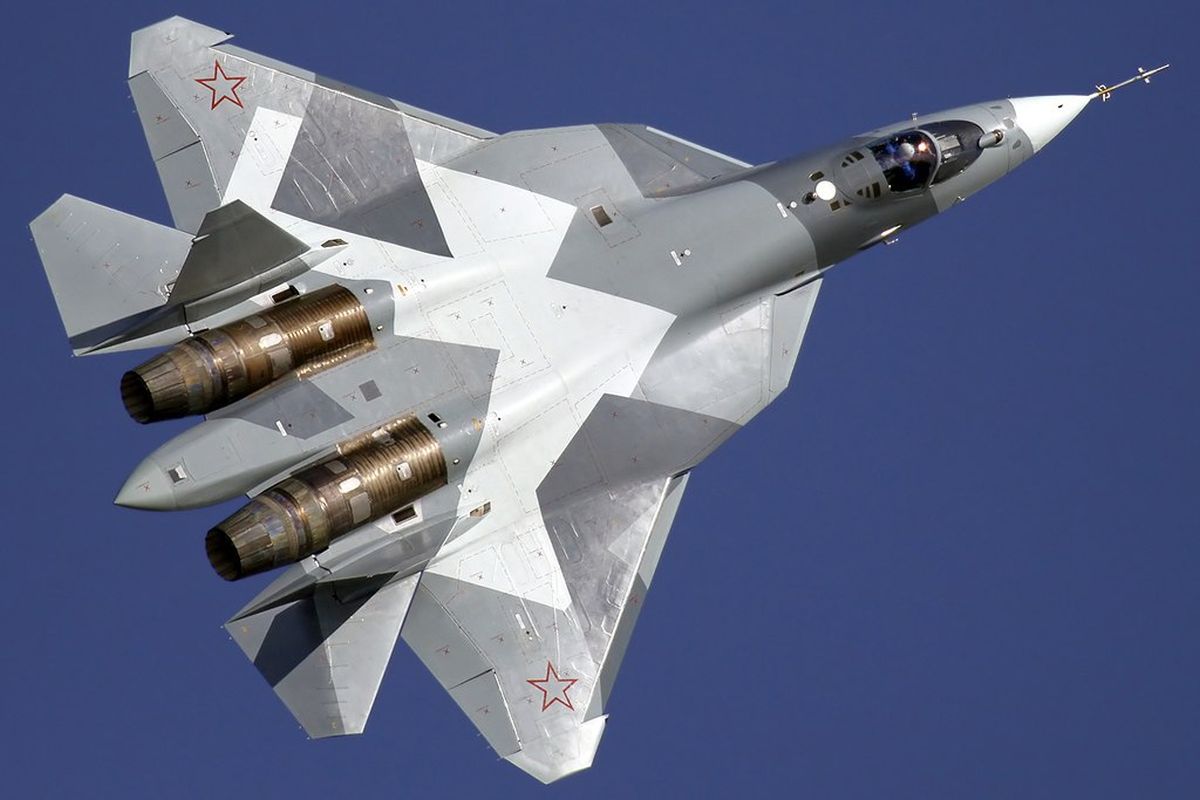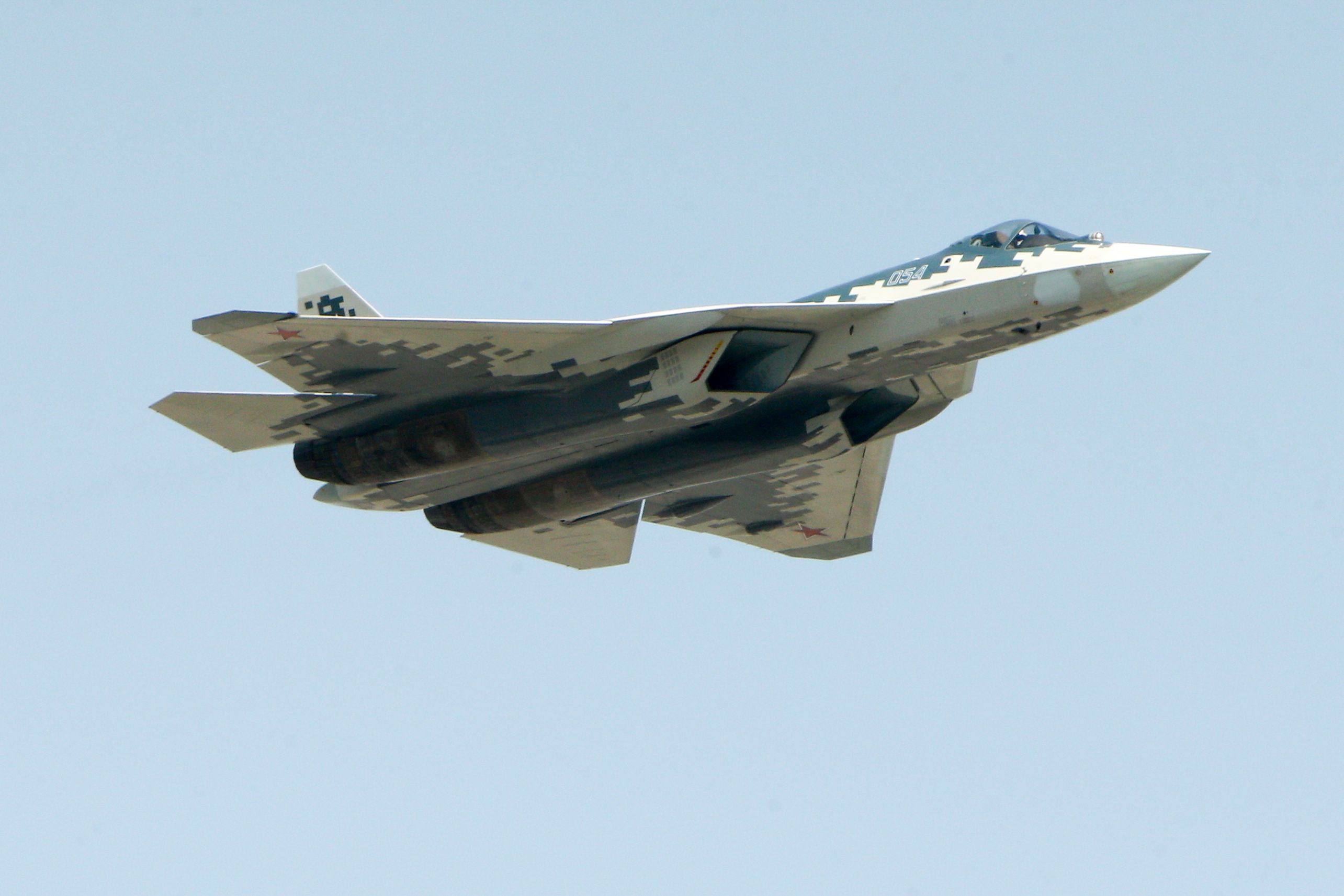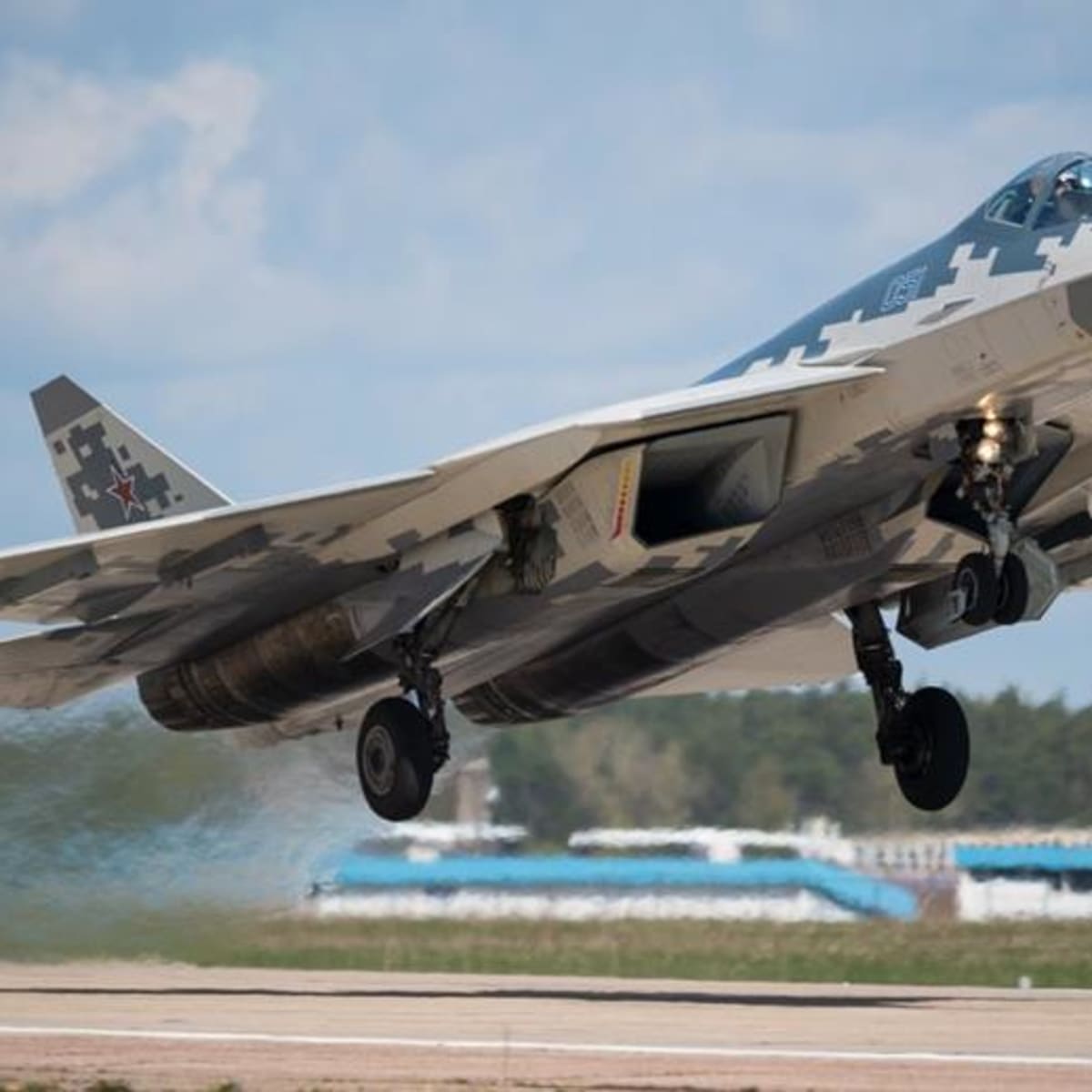Russia Su 57 - It is the product of the PAK FA (Russian: ПАК ФА, short for: Перспективный авиационный комплекс фронтовой авиации, romanized: Perspectivany avivoyyy'er started as a more modern 9. Mikoyan 1.44/ 1.42).Sukhoi's internal designation for the aircraft is T -50. The Su-57 is the first Russian military service aircraft designed with stealth technology and is intended to be the basis of a family of stealth fighter aircraft.
A multirole fighter capable of air combat as well as land and sea attack, the Su-57 includes stealth, super maneuverability, super cruise, integrated avionics and substantial internal cargo capacity.
Russia Su 57

The aircraft is expected to succeed the MiG-29 and Su-27 in Russian military service and has also been sold for export. The first prototype aircraft flew in 2010, but the program would experience longer development due to various structural and technical problems that arose during testing, including the destruction of the first production aircraft in a crash before delivery. After repeated delays, the first Su-57 entered service with the Russian Aerospace Forces (VKS)
Video Shows Russian Sukhoi Su 57 Stealth Fighters Deploying To Syria
In 1979, the Soviet Union recognized the need for the next generation of fighter aircraft intended for service in the 1990s. The program became the I-90 (Russian: И-90, short for: Истребитель 1990–х годов, lit. . 'Fighter the 1990s') and required that the fighter "multifunctional" (that is to say have important ground) attack capabilities, and would eventually replace the MiG-29 and Su-27 in front-line tactical aviation service. Two later projects were designed to meet these requirements: the IMF (Russian: EMF (МфНои, ,ййи for фрон, лёр, люР, мюр, люр, люр, люр, 2016, line fighter). '), with conceptual work that started in 1983.
Although not involved in MFI, in 1983 Sukhoi began its own program to develop technologies for a next-generation fighter, which eventually resulted in the S-32 advanced wing experimental aircraft, later renamed S-37 and Su-47. Due to a lack of funds after the dissolution of the Soviet Union, the MFI was repeatedly delayed and the first flight of the prototype MiG 1.44/1.42 did not happen until 2000, nine years late.
Due to high costs, the IMF and LFI were eventually canceled while the Russian Ministry of Defense began work on a new next-generation fighter program; in 1999, the ministry started the PAK FA or I-21 program, with the tender announced in April 2001.
Due to Russia's financial difficulties, the program aimed to limit costs by producing a single fifth-generation multirole fighter that would replace both the Su-27 and the MiG-29. Other cost-saving measures include a projected size between that of the Su-27 and the MiG-29, and a significantly lower normal take-off weight than the 28.6 tons of the MiG MFI (63,000 lb) and the Su-47 (59,000 lb ). 000 lbs).
Sukhoi Su 57
Sukhoi's approach to the PAK FA competition differed fundamentally from Mikoyan's; while Mikoyan proposed that the three design offices (Mikoyan, Sukhoi, and Yakovlev) work together as a consortium with the winning team leading the design effort, Sukhoi's proposal had itself as the lead designer from the start and included a joint work agreement covering the tire production and development cycle, from propulsion and avionics suppliers to research facilities. In addition, the two companies had different design philosophies for the aircraft. Mikoyan's E-721 was smaller and more economical, with a normal take-off weight of 16–17 tonnes (35,000–37,000 lb) and powered by a pair of Klimov VK-10M engines rated at 10–11 tonnes (98.1 to 108 kN). , 22,000–24,300 lbf) of thrust each. In contrast, Sukhoi's T-50 would be relatively larger and more capable, with a normal takeoff weight target of 22–23 tonnes (49,000–51,000 lb) and powered by a pair of Lyulka-Saturn AL-41F1 engines each with maximum thrust in class of 14.5 tons (142 kN, 32,000 lbf).
In April 2002, the Ministry of Defense selected Sukhoi over Mikoyan as the winner of the PAK FA competition and the main design agency for the new aircraft.
In addition to the merits of the proposal, Sukhoi's experience in the 90s was taken into account, with the successful development of several derivatives of the Su-27 and many exports that ensured its financial stability.

Mikoyan continued to develop his E-721 as the LMFS (Russian: ЛМФС, short for: Лёгкий многофункциональный фронтовой Флават, lit. 'Airborne its own front line).
Russia's Su 57 Stealth Fighter Prepares To Join China's J 20 At Zhuhai Airshow; Mig 35, Su 35 'add To Spice'
The PAK FA research and development program was named Stolitsa (Russian: Столица, literally "capital"). In 2002, Alexander Davidko was selected as chief designer of the T-50 at Sukhoi.
The Novosibirsk Aircraft Production Association (NAPO) and the Komsomolsk-on-Amur Aircraft Production Association (KnAAZ) would produce the new multirole fighter, with KnAAZ carrying out the final assembly in Komsomol'sk-on-Amur.
After a competition held in 2003, Tekhnokompleks Scientific and Production Cter, Ramskoye Instrument Building Design Bureau, Tikhomirov Scientific Research Institute of Instrument Design (NIIP), Ural Optical and Mechanical Plant (UOMZ) in Yekaterinburg, Polet company in Nizhny Novgorod and the Ctral Scientific Research Radio Engineering Institute in Moscow were selected for the development of the PAK FA avionics suite. In April 2004, NPO Lyulka-Saturnus (now NPO Saturnus) was signed as the contractor for the AL-41F1 engines under the development name izdeliye 117.
Sukhoi used existing airframes as test beds for various subsystems and concepts; the Su-47 tested the internal weapons bays, and the Su-27M prototypes served as test beds for the flight control system and engines.
The Su 57 Is Marketed As Stealth Fighter But Radars Have Between 6 To 10 Times Greater Detection Range Against The Felon Compared To F 22 & F 35. Here's Why.
To reduce development risk and spread associated costs, as well as to bridge the gap with existing fourth-generation fighters, Sukhoi implemented some of the technologies and features of the T-50, such as propulsion and certain avionics, in an advanced derivative of the Su-50 27 called the T-10BM (Russian: БМ, short for: большая модностирация, lit. 'Major Modernization'), which was eventually acquired by the Russian Ministry of Defense in 2009 and served as the Su -2014S.
In December 2004, the conceptual design and shape of the T-50 was completed and approved by the Ministry of Defense; Government funding for the program began in 2005 and increased dramatically in 2006, when detailed design was underway.
On August 8, 2007, the Commander-in-Chief of the Russian Air Force, Alexander Zelin, was quoted by Russian news agencies as saying that the development phase of the program was complete and construction of the first test aircraft would begin, with three planned flyable T -50 prototypes. built in 2009.

From the early stages of the PAK FA program, Russia sought foreign partnerships in the project to increase funding for its development as well as secure large export orders.
Russia Working To Integrate S 70 Okhotnik Ucavs In Su 57 Felon Squadrons
On 18 October 2007, Russia and India signed a contract for Sukhoi and Hindustan Aeronautics Limited (HAL) to jointly develop a derivative of the PAK FA called the Fifth Generation Fighter Aircraft (FGFA).
In September 2010, India and Russia agreed to a preliminary draft contract in which each country would invest $ 6 billion; a Memorandum of Understanding for the preliminary project was signed in December 2010 and the development of the FGFA would take 8–10 years.
However, in 2014, the Indian Air Force began to worry about performance, cost and division of labor. India eventually left the partnership in 2018.
The first flight of the T-50 has been postponed several times since the beginning of 2007 after encountering unspecified technical problems. In August 2009, Alexander Zelin admitted that problems with the engine and in technical research remained unsolved.
Russia's Most Advanced Fighter Arrives In Syria
On February 28, 2009, Sukhoi CEO Mikhail Pogosyan announced that the aircraft was almost complete and that the first prototype would be ready in August 2009.
On August 20, 2009, Pogosyan said that the first flight by the year d. Konstantin Makiyko, deputy head of the Moscow-based Center for Analysis of Strategies and Technologies, said that "even with delays", the plane will probably make its first flight in January or February, adding that its commercial production will take five to t years would .
Flight tests were further delayed when Deputy Prime Minister Sergei Ivanov announced in December 2009 that the first tests would begin in 2010.

The first taxi test was successfully completed on 24 December 2009 and the service flight of the first prototype aircraft, the T-50-1, took place on 29 January 2010.
Sukhoi Su 57 Enters Mass Productions, Gives Russia A Fighter To Take On Us F 22 Raptor, F 35 Lightning Ii
Piloted by Sukhoi test pilot Sergey Bogdan, the aircraft's 47-minute service flight took place at KnAAPO's Dzemgi Airport in the Russian Far East.
The construction of the prototypes would proceed more slowly than initially planned; by October 2013, the test program had collected more than 450 flights in five aircraft.
A total of flying and three non-flying T-50 prototypes would be built for preliminary flight testing and state testing.
Initially, the program was planned to have up to six prototypes before the start of serial production; however, testing would show that early prototypes did not have adequate fatigue life, with early structural cracks forming in the airframe.
Russia Releases Images Of Su 57 And Checkmate Fighters Together
The aircraft later underwent a structural redesign, with changes including increased use of composite material, reinforced aircraft to meet full life cycle requirements, elongated tail "sting" and a slightly larger wingspan; the sixth flyable prototype was the first of the redesigned "second stage" aircraft, with the first five prototypes considered "first stage" vehicles and requiring additional structural reinforcements to continue flight testing.
The last two flying prototypes were production test articles of Su-57 aircraft with full mission systems on board.
While the structural reorganization of the "second stage" reduced the growth of the required power weight

Su 57 rc plane, su 57 rc jet, su 57 model kit, su 57 3d model, su 57 paper model, su 57 diecast, su-57, su 57 war thunder, su 57 diecast model, su 57 plane, su 57, su 57 fighter jet
0 Comments